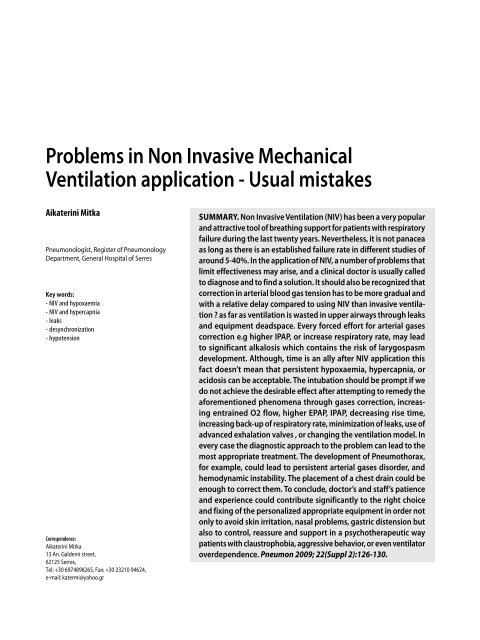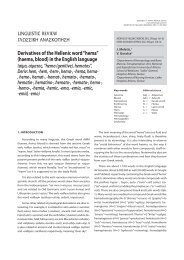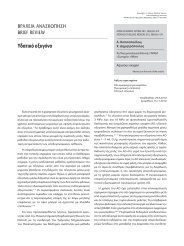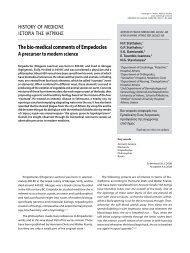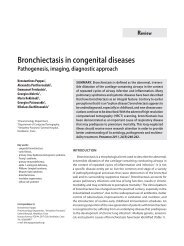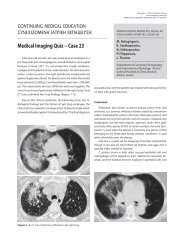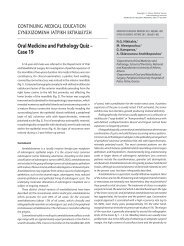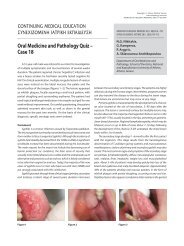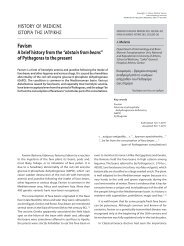Problems in Non Invasive Mechanical Ventilation application - Usual ...
Problems in Non Invasive Mechanical Ventilation application - Usual ...
Problems in Non Invasive Mechanical Ventilation application - Usual ...
Create successful ePaper yourself
Turn your PDF publications into a flip-book with our unique Google optimized e-Paper software.
<strong>Problems</strong> <strong>in</strong> <strong>Non</strong> <strong>Invasive</strong> <strong>Mechanical</strong><br />
<strong>Ventilation</strong> <strong>application</strong> - <strong>Usual</strong> mistakes<br />
Aikater<strong>in</strong>i Mitka<br />
Pneumonologist, Register of Pneumonology<br />
Department, General Hospital of Serres<br />
Key words:<br />
- NIV and hypoxaemia<br />
- NIV and hypercapnia<br />
- leaks<br />
- desynchronization<br />
- hypotension<br />
Correspondence:<br />
Aikater<strong>in</strong>i Mitka<br />
13 An. Galdemi street,<br />
62125 Serres,<br />
Tel: +30 6974898265, Fax: +30 23210 94624,<br />
e-mail: katermi@yahoo.gr<br />
SummArY. <strong>Non</strong> <strong>Invasive</strong> <strong>Ventilation</strong> (NIV) has been a very popular<br />
and attractive tool of breath<strong>in</strong>g support for patients with respiratory<br />
failure dur<strong>in</strong>g the last twenty years. Nevertheless, it is not panacea<br />
as long as there is an established failure rate <strong>in</strong> different studies of<br />
around 5-40%. In the <strong>application</strong> of NIV, a number of problems that<br />
limit effectiveness may arise, and a cl<strong>in</strong>ical doctor is usually called<br />
to diagnose and to f<strong>in</strong>d a solution. It should also be recognized that<br />
correction <strong>in</strong> arterial blood gas tension has to be more gradual and<br />
with a relative delay compared to us<strong>in</strong>g NIV than <strong>in</strong>vasive ventilation<br />
? as far as ventilation is wasted <strong>in</strong> upper airways through leaks<br />
and equipment deadspace. Every forced effort for arterial gases<br />
correction e.g higher IPAP, or <strong>in</strong>crease respiratory rate, may lead<br />
to significant alkalosis which conta<strong>in</strong>s the risk of larygospasm<br />
development. Although, time is an ally after NIV <strong>application</strong> this<br />
fact doesn’t mean that persistent hypoxaemia, hypercapnia, or<br />
acidosis can be acceptable. The <strong>in</strong>tubation should be prompt if we<br />
do not achieve the desirable effect after attempt<strong>in</strong>g to remedy the<br />
aforementioned phenomena through gases correction, <strong>in</strong>creas<strong>in</strong>g<br />
entra<strong>in</strong>ed O2 flow, higher EPAP, IPAP, decreas<strong>in</strong>g rise time,<br />
<strong>in</strong>creas<strong>in</strong>g back-up of respiratory rate, m<strong>in</strong>imization of leaks, use of<br />
advanced exhalation valves , or chang<strong>in</strong>g the ventilation model. In<br />
every case the diagnostic approach to the problem can lead to the<br />
most appropriate treatment. The development of Pneumothorax,<br />
for example, could lead to persistent arterial gases disorder, and<br />
hemodynamic <strong>in</strong>stability. The placement of a chest dra<strong>in</strong> could be<br />
enough to correct them. To conclude, doctor’s and staff’s patience<br />
and experience could contribute significantly to the right choice<br />
and fix<strong>in</strong>g of the personalized appropriate equipment <strong>in</strong> order not<br />
only to avoid sk<strong>in</strong> irritation, nasal problems, gastric distension but<br />
also to control, reassure and support <strong>in</strong> a psychotherapeutic way<br />
patients with claustrophobia, aggressive behavior, or even ventilator<br />
overdependence. Pneumon 2009; 22(Suppl 2):126-130.
PNEUMON Supplement 2, Vol. 22, 2009<br />
The <strong>Non</strong> <strong>Invasive</strong> <strong>Ventilation</strong> (NIV) is a very popular<br />
and attractive tool of breath<strong>in</strong>g support for patients<br />
with respiratory failure dur<strong>in</strong>g the last twenty years. The<br />
NIV’s <strong>application</strong> potentially reduces hospital morbidity,<br />
expedites wean<strong>in</strong>g, effectively reduc<strong>in</strong>g complications<br />
and hospitalization costs <strong>in</strong> patients suffer<strong>in</strong>g from acute<br />
respiratory failure. In cases of chronic respiratory failure,<br />
NIV contributes considerably <strong>in</strong> the survival and quality<br />
of life of these patients. Nevertheless, it is not panacea.<br />
There is an established failure rate <strong>in</strong> different studies<br />
of around 5-40%. It is described either as primary (immediately<br />
after <strong>application</strong>) or late (<strong>in</strong> patients already<br />
established on NIV) failure. Successful <strong>application</strong> is<br />
determ<strong>in</strong>ed by the appropriate selection of patients,<br />
underly<strong>in</strong>g pathology, correct choice of equipment and<br />
staff’s experience. 1-12,18<br />
In the <strong>application</strong> of NIV, a number of problems that<br />
limit effectiveness may arise. With appropriate guidance<br />
and simple measures-outl<strong>in</strong>ed below- these problems can<br />
be overcome and the outcome become successful.<br />
PERSISTENT HYPERCAPNIA<br />
proBlem: The PCO2 tension cont<strong>in</strong>ues to be high<br />
after the <strong>in</strong>itiation of <strong>Non</strong> <strong>Invasive</strong> <strong>Ventilation</strong>.<br />
CAuSeS: Inspiratory pressure, tidal volume or backup<br />
respiratory rate may be too low. Also, leaks from<br />
<strong>in</strong>terface, CO2 rebreath<strong>in</strong>g, asynchrony between patient<br />
and ventilator, <strong>in</strong>sufficient duration of time on NIV,<br />
<strong>in</strong>appropriate oxygenation are conditions which could<br />
contribute to CO2 <strong>in</strong>crease and it is required that they<br />
be tackled promptly.<br />
ACtIoN: The <strong>in</strong>crease of the <strong>in</strong>spiratory pressure (IPAP),<br />
or obligatory volume sett<strong>in</strong>g contribute to <strong>in</strong>crease of<br />
ventilation and <strong>in</strong> that way to CO2 decrease. Inspiratory<br />
pressure should be <strong>in</strong>creased gradually by around 2cmH2O<br />
at a time. A higher back-up respiratory rate may help especially<br />
dur<strong>in</strong>g sleep. Leaks from the mask and asynchrony<br />
between patient and ventilator will be discussed later.<br />
In case of CO2 rebreath<strong>in</strong>g, mask and tub<strong>in</strong>g deadspace<br />
should be m<strong>in</strong>imized. The m<strong>in</strong>imum expiratory positive<br />
pressure (EPAP) of at least 4cmH2O is necessary to avert<br />
CO2 rebreath<strong>in</strong>g. The problem may be ameliorated also<br />
by us<strong>in</strong>g exhalation valve such as plateau or NRB (nonrebreath<strong>in</strong>g),<br />
and ventilators with separate <strong>in</strong>spiratory and<br />
expiratory tub<strong>in</strong>g. Be careful <strong>in</strong> over-oxygenation case,<br />
especially <strong>in</strong> hypercapnic patients. The patient spend<strong>in</strong>g<br />
127<br />
time <strong>in</strong> NIV is an important ally to a successful outcome.<br />
Often, the patients need to be encouraged to susta<strong>in</strong><br />
usage for a greater time period. 13-15,17<br />
PERSISTENT HYPOXEMIA<br />
proBlem: The O2 tension rema<strong>in</strong>s low on NIV.<br />
ACtIoN: Provided that the ventilation is optimum<br />
(check PCO2), should <strong>in</strong>crease the O2 flow via T-piece<br />
<strong>in</strong>to circuit or ventilator oxygen mixer or via porthole <strong>in</strong><br />
mask, achiev<strong>in</strong>g higher FiO2 than via circuit. The <strong>in</strong>crease<br />
<strong>in</strong> Inspiratory time (Ti) and Expiratory Pressure (EPAP=6/<br />
7cmH2O) may be helpful to recruit alveoli and <strong>in</strong>crease<br />
functional residual capacity (FRC) especially <strong>in</strong> patients<br />
with pulmonary edema and atelectasis. The helmet mask<br />
may also be useful <strong>in</strong> hypoxemic situations. 14,20<br />
HYPOCAPNIA/RESPIRATORY ALKALOSIS<br />
proBlem: PaCO2 falls too fast after <strong>in</strong>itiation of<br />
NIV.<br />
CAuSeS: The m<strong>in</strong>ute ventilation is too high because<br />
of either too high IPAP or Tidal Volume or back-up respiratory<br />
rate.<br />
ACtIoN: Decrease IPAP or Tidal volume or back-up<br />
respiratory rate. Laryngospasm may occasionally be seen<br />
as protective mechanism to further CO2 decreases. If this<br />
occurs it is necessary to discont<strong>in</strong>ue ventilation until the<br />
patient recovers and restart usage aga<strong>in</strong> at lower <strong>in</strong>spiratory<br />
pressure / tidal volume. 14<br />
LEAKS<br />
proBlem: Leaks from mask caus<strong>in</strong>g <strong>in</strong>efficient ventilation,<br />
eye irritation, dry mouth, nasal symptoms, noise.<br />
They are reported <strong>in</strong> 80-100% of cases.<br />
ACtIoN: Take time to choose the appropriate mask<br />
(size, type) careful <strong>application</strong> and fix<strong>in</strong>g. Fullface and<br />
totalface masks reduce to zero mouth΄s leaks. These<br />
can also be reduced by a ch<strong>in</strong> strap, cervical collar, and<br />
denture keep<strong>in</strong>g <strong>in</strong> edentulous patients. The patients<br />
tra<strong>in</strong><strong>in</strong>g to put their own mask may have satisfactory<br />
results. In some cases l<strong>in</strong><strong>in</strong>g the mask with soft towel<strong>in</strong>g<br />
strip may reduce the leaks and protect sk<strong>in</strong> irritation. It<br />
is important to know that m<strong>in</strong>or leaks are <strong>in</strong>evitable and<br />
can be acceptable because they will be compensated by<br />
ventilators. 13-16
128 ΠΝΕΥΜΩΝ Συμπληρωματικό Τεύχος 2ο, Τόμος 22ος, 2009<br />
ASYNCHRONY BETwEEN PATIENT AND<br />
VENTILATOR<br />
proBlem: Desynchronization between patient ΄s<br />
<strong>in</strong>spiratory effort and ventilator ΄s trigger<strong>in</strong>g result<strong>in</strong>g <strong>in</strong><br />
persistent hypercapnia, hypoxaemia, leaks, anxiety.<br />
ACtIoN: The most common cause of desynchronization<br />
is mouth breath<strong>in</strong>g <strong>in</strong> patient us<strong>in</strong>g a nasal mask. The<br />
ventilator doesn’t recognize patient’s respiratory efforts<br />
and cycle at the back-up respiratory rate. A fullface mask<br />
may help synchroniz<strong>in</strong>g. Another important cause may<br />
be the fact that the ventilatory <strong>in</strong>spiratory pressure is not<br />
enough for patient‘s demand or cycl<strong>in</strong>g to expiration does<br />
not occur effectively. Presett<strong>in</strong>g a maximum <strong>in</strong>spiratory<br />
time (max Ti) can be useful <strong>in</strong> COPD patients (m<strong>in</strong>imizes<br />
wasted <strong>in</strong>spiratory efforts lead<strong>in</strong>g to gas trapp<strong>in</strong>g and<br />
leaks). A m<strong>in</strong>imum <strong>in</strong>spiratory time (m<strong>in</strong> Ti) sett<strong>in</strong>g can<br />
assist patients with restrictive disorders <strong>in</strong> avoid<strong>in</strong>g premature<br />
cycl<strong>in</strong>g to EPAP. For patients suffer<strong>in</strong>g from acute<br />
dyspnoia a sort rise time (time to reach IPAP from trigger<strong>in</strong>g)<br />
is suitable. Particular attention is required <strong>in</strong> trigger<br />
sett<strong>in</strong>gs which may lead either to false recognition of<br />
patient’s respiratory effort thus result<strong>in</strong>g <strong>in</strong> premature<br />
breaths or to no recognition of patient’s respiratory effort<br />
result<strong>in</strong>g <strong>in</strong> no ventilator trigger<strong>in</strong>g. Given that the<br />
dyschronization problem is complex and multifaceted,<br />
ventilators with visual screen waveforms can help. All the<br />
above should be checked after the case of mechanical<br />
malfunction has been discarded. 14,24,25<br />
AGGRESSIVE PATIENT/PATIENT IN CONFUSE<br />
proBlem: The patient who suffers from sever hypoxaemia<br />
and hypercapnia is often confused, disorientated<br />
caus<strong>in</strong>g him difficulty <strong>in</strong> <strong>in</strong>itiation and cooperation with<br />
NIV.<br />
ACtIoN: The patient should be moved to an area<br />
where supervision is available (HDU, ICU). Fitt<strong>in</strong>g fullface<br />
or totalface mask with entra<strong>in</strong>ed O2 <strong>in</strong> order to correct<br />
hypoxemia as soon as possible, is useful. If the patient<br />
cont<strong>in</strong>ues to be confused, behaves aggressively and<br />
cannot be synchronized with NIV, then a small dose of<br />
sedative may be <strong>in</strong>itiated. In this case, haloperidol (2 mg<br />
PO, IM or IV) or diamorph<strong>in</strong>e especially <strong>in</strong> patients with<br />
pulmonary edema should be preferred. If these measures<br />
cannot control agitation, further sedation and <strong>in</strong>tubation<br />
are required. 14<br />
CLAUSTROPHOBIA<br />
proBlem: Claustrophobia is met <strong>in</strong> 5-10% of patients<br />
who suffer from hypoxemia and it is made worse by the<br />
use of NIV’s mask.<br />
ACtIoN: Prompt correction of hypoxaemia and cont<strong>in</strong>uance<br />
the saturation of arterial blood more than 90%.<br />
Usage of a smaller <strong>in</strong>terface or nasal plugs. Paradoxically,<br />
the total face mask covers the whole face but vision is<br />
undisturbed thus reduc<strong>in</strong>g claustrophobic feel<strong>in</strong>gs <strong>in</strong> a<br />
large number of patients. A psychotherapeutic approach<br />
may be solv<strong>in</strong>g the problem. In some cases a small dose<br />
of sedation or even and <strong>in</strong>tubation is required. 14-16<br />
TROUBLESOME COUGH<br />
proBlem: Sometimes after NIV <strong>application</strong>, the<br />
patients experience <strong>in</strong>tense and productive cough<strong>in</strong>g<br />
due to an airway cool<strong>in</strong>g and dry<strong>in</strong>g effect, and mobilization<br />
of secretions. This is, of course, more common<br />
<strong>in</strong> patients with Cystic Fibrosis, Bronchiectasis, Asthma,<br />
COPD because of underly<strong>in</strong>g <strong>in</strong>flammation.<br />
ACtIoN: Heated humidification comb<strong>in</strong>ed with physiotherapy<br />
to clear secretions and the appropriate treatment<br />
is the solution. 3<br />
GASTRIC DISTENSION<br />
proBlem: Abdom<strong>in</strong>al pa<strong>in</strong>, <strong>in</strong>sufflation, dysphoria<br />
after NIV <strong>in</strong>itiation is reported <strong>in</strong> up to 50% of patients but<br />
is rarely <strong>in</strong>tolerable. These symptoms are more common<br />
<strong>in</strong> patients with neuromuscular disease and paradoxically<br />
those with high thoracic impedance.<br />
CAuSe: The most important reason of gastric distension<br />
appearance is aerophagia.<br />
ACtIoN: Reposition<strong>in</strong>g <strong>in</strong> bed and avoidance of<br />
carbonated dr<strong>in</strong>ks seem to cooperate <strong>in</strong> reduc<strong>in</strong>g the<br />
problem’s effects. Changes <strong>in</strong> ventilator sett<strong>in</strong>gs may<br />
be required: decreas<strong>in</strong>g the <strong>in</strong>spiratory pressure or tidal<br />
volume and compensat<strong>in</strong>g them by <strong>in</strong>creas<strong>in</strong>g the backup<br />
rate or, swapp<strong>in</strong>g from a volume to pressure –limited<br />
model. In some cases a rh<strong>in</strong>ogastric tube and H2 antagonist<br />
may offer relief to patients. 13-15<br />
NASAL AND FACE SORE<br />
proBlem: Nasal soreness, congestion, stream<strong>in</strong>g,<br />
bleed<strong>in</strong>g, nasal bridge irritation, face rash. The patients
PNEUMON Supplement 2, Vol. 22, 2009<br />
may experience these problems especially when they<br />
are us<strong>in</strong>g NIV for prolonged period <strong>in</strong> rates between<br />
5-30%.<br />
ACtIoN:<br />
NASAL BRIDGE SKIN IRRITATION: the best way to<br />
protect nasal bridge sk<strong>in</strong> from irritation is the correct<br />
choice of size, type of the mask and straps. Strap tension<br />
should be adjusted <strong>in</strong> such a way that two f<strong>in</strong>gers can be<br />
accommodated under them. Artificial sk<strong>in</strong> (duoderm) is<br />
suggested to be used when excessive pressure applied<br />
for a long time usually leads to ulceration. L<strong>in</strong><strong>in</strong>g the mask<br />
with soft towel<strong>in</strong>g strip protects the sk<strong>in</strong> from irritation.<br />
We also propose the topical use of corticosteroid and<br />
antibiotic cream. If a better result is impossible, it may be<br />
helpful to use an alternative <strong>in</strong>terface, like total face, nasal<br />
plugs, or stopp<strong>in</strong>g NIV for a few days if it is safe.<br />
NASAL CONGESTION/ NASAL STREAMING: The use<br />
of topical vasoconstrictors (ephedr<strong>in</strong>e % nose drops or<br />
dexarh<strong>in</strong>aspray) which may help with acute congestion<br />
could be proposed. When longer term use is required, a<br />
nasal steroid can be employed, while <strong>in</strong> nasal stream<strong>in</strong>g<br />
cases, ipratropium bromide spray can help. Don’t forget<br />
that mouth leaks cause a compensatory <strong>in</strong>crease <strong>in</strong> flow<br />
through the nose and a full face mask is sufficient <strong>in</strong> order<br />
to reduce the symptoms.<br />
EPISTAXIS/NOSE BLEEDS: Topical measures should be<br />
taken: vasoconstrictors, pressure, and tamponade. When<br />
NIV is be<strong>in</strong>g used <strong>in</strong>tensively, humidification use could<br />
protect and relief from described symptoms. 13-16,21,26-28<br />
EYE IRRITATION<br />
proBlem: Eye irritation is an adverse effect after NIV<br />
<strong>application</strong> which has been reported <strong>in</strong> up to a third of<br />
patients. It caused by leakage of the mask on the sides<br />
of the nose where effective seal<strong>in</strong>g is difficult.<br />
ACtIoN: Sooth<strong>in</strong>g eye drops may br<strong>in</strong>g some relief<br />
of irritation Alternatives such as add<strong>in</strong>g comfort flaps or<br />
try<strong>in</strong>g a bubble mask or nasal pillows may correct the<br />
problem. 1-2<br />
PNEUMOTHORAX<br />
proBlem: It is a rare complication (
130 ΠΝΕΥΜΩΝ Συμπληρωματικό Τεύχος 2ο, Τόμος 22ος, 2009<br />
significantly by pay<strong>in</strong>g careful attention to mask usage<br />
and by giv<strong>in</strong>g the patient adequate time to adapt with<br />
the ventilator. Technologic improvements <strong>in</strong> <strong>in</strong>terfaces<br />
and ventilators construction can assure further tolerance<br />
and compliance. Air leak<strong>in</strong>g ma<strong>in</strong>ly occurs by nasal mask<br />
us<strong>in</strong>g and may occasionally <strong>in</strong>terfere with satisfactory<br />
ventilation and sleep quality. CO2 rebreath<strong>in</strong>g associated<br />
with bi-level-type ventilator may also <strong>in</strong>terfere with the<br />
ability to ventilate effectively but these effects have not<br />
been studied extensively <strong>in</strong> real life –non laboratory-<br />
conditions. Persistent hypercapnia, hypoxaemia, alkalosis,<br />
confusional state, cough, and gastric distension are usually<br />
dealt directly provided that we have comprehended the<br />
underly<strong>in</strong>g pathology and the ventilator’s capabilities.<br />
Major complications such as aspiration pneumonia,<br />
hypotension, and barotrauma are not frequent. Exclusion<br />
of <strong>in</strong>appropriate candidates and careful attention to<br />
patients dur<strong>in</strong>g NIV <strong>in</strong>itiation may help to m<strong>in</strong>imize<br />
complications to assure the optimal use of NIV and <strong>in</strong><br />
that way, assist towards a successful outcome for our<br />
patients.<br />
REFERENCES<br />
1. Hill NS. Complication of positive pressure ventilation. Respiratory<br />
care April 1997 Vol 42 No 4.<br />
2. Gay PC. Complication of non<strong>in</strong>vasive ventilation <strong>in</strong> acute care.<br />
Respiratory care February 2009 Vol 54 No2.<br />
3. Heather S, Chatw<strong>in</strong> M, Simonds AK, <strong>in</strong> Simonds AK editor <strong>Non</strong><br />
<strong>in</strong>vasive respiratory support. Edward Arnold (publishers) Ltd<br />
2007: 113-122.<br />
4. Antoneli M, Gonti G, Rocco M, et al. A comparison of NIPPV<br />
and conventional mechanical ventilation <strong>in</strong> patients with acute<br />
respiratory failure. N Engl J Med 1998; 339:429-435.<br />
5. Hess D. Evidence for <strong>Non</strong><strong>in</strong>vasive Positive-Pressure <strong>Ventilation</strong><br />
<strong>in</strong> the Care of Patients <strong>in</strong> Acute Respiratory Failure: A Systematic<br />
Review of the Literature. Respiratory Care Journal 2004;<br />
49:7.<br />
6. Meduri G, Turner RE et al. <strong>Non</strong><strong>in</strong>vasive Positive Pressure <strong>Ventilation</strong><br />
Via Face Mask Chest January 1996; 109:179-193.<br />
7. Garpestand E, Brennan J, Hill NS. Postgraduate educational<br />
corner-Contemporary reviews <strong>in</strong> critical care medic<strong>in</strong>e <strong>Non</strong><strong>in</strong>vasive<br />
<strong>Ventilation</strong> for Critical Care* Chest August 2007<br />
132:711-720.<br />
8. Honrubia T et al. <strong>Non</strong><strong>in</strong>vasive vs Conventional <strong>Mechanical</strong><br />
<strong>Ventilation</strong> <strong>in</strong> Acute Respiratory Failure Chest December 2005<br />
128:3916-3924.<br />
9. Leisch<strong>in</strong>g T, Kwok H, Hill NS. Acute Applications of <strong>Non</strong><strong>in</strong>vasive<br />
Positive Pressure <strong>Ventilation</strong>* Chest August 2003 124:699-<br />
713.<br />
10. Haworth CS, Dodd ME, Atk<strong>in</strong>s M, Woodcock AA, Webb AK.<br />
Pneumothorax <strong>in</strong> adults with cystic fibrosis dependent on<br />
nasal <strong>in</strong>termittent positive pressure ventilation (NIPPV): a<br />
management dilemma. Thorax, Jul 2000; 55: 620 - 622.<br />
11. Antonelli, M et al. <strong>Non</strong><strong>in</strong>vasive Positive Pressure <strong>Ventilation</strong><br />
Us<strong>in</strong>g a Helmet <strong>in</strong> Patients with Acute Exacerbation of Chronic<br />
Obstructive Pulmonary Disease: A Feasibility Study Anesthesiology.<br />
100:16-24, January 2004.<br />
12. Navalesi P, Fanfulla F, Frigerio P, Gregoretti C, Nava, S. Physiologic<br />
evaluation of non<strong>in</strong>vasive mechanical ventilation delivered<br />
with three types of masks <strong>in</strong> patients with chronic<br />
hypercapnic respiratory failure Critical Care Medic<strong>in</strong>e, 2000;<br />
28:1785-1790.<br />
13. Evans T. International consensus conferences <strong>in</strong> <strong>in</strong>tensive care<br />
medic<strong>in</strong>e: NIPPV <strong>in</strong> acute respiratory failure. Intensive care<br />
medic<strong>in</strong>e 2001; 27:166-178.<br />
14. Antonelli M. Cl<strong>in</strong>ical review: NIV <strong>in</strong> the cl<strong>in</strong>ical sett<strong>in</strong>g. Experience<br />
from the past 10 years. Crit Care 2005;9:98-103.<br />
15. Madden MB et al. NIV <strong>in</strong> cystic fibrosis patients with acute or<br />
chronic respiratory failure. Eur Resp J 2002;19:310-313.<br />
16. Torrens JB et al. Haemodynamic and endocr<strong>in</strong>ological effects<br />
of NIV <strong>in</strong> respiratory failure. Eur Resp J 1997;10:2553-2559.<br />
17. Nilsestuen JO. Us<strong>in</strong>g ventilator graphics to identify patientventilator<br />
asynchrony. Respir Care 2005; 50(2):202-232.<br />
18. Fabry B, Guttman J et al. An analysis of desynchronization<br />
between the spontaneously breath<strong>in</strong>g patient and ventilator<br />
dur<strong>in</strong>g <strong>in</strong>spiratory pressure support. Chest 1995; 107:1387-<br />
1394.<br />
19. Schonhofer B, Sortor-Leger S. Equipment needs for non<strong>in</strong>vasive<br />
mechanical ventilation. Eur Resp J 2002; 20:1029-1036.<br />
20. Elliot MW. The <strong>in</strong>terface: crucial for successful NIV. Eur Resp J<br />
2004;23:7-8.<br />
21. Lightowler JV, Elliot MV. Predict<strong>in</strong>g outcome from NIV <strong>in</strong> acute<br />
exacerbation of COPD. Thorax 2000;55:815-816.<br />
22. Hore Chrag T. NIPPV <strong>in</strong> patients with ARF. Emerg Med 14:281-<br />
295.<br />
23. Lellouche F et al. Effect of humidification device on the work<br />
of breath<strong>in</strong>g dur<strong>in</strong>g NIV. Intensive Care Med 2002;28:1582-<br />
1589.<br />
24. Antonelli M. NIV for treatment of acute respiratory failure<br />
<strong>in</strong> patients undergo<strong>in</strong>g solid organ transplantation. JAMA<br />
2000;283:235-241.<br />
25. Antonelli M. New advances <strong>in</strong> the use of NIV for acute hypoxaemic<br />
respiratory failure. Eur Resp J 2003;22:65-71.<br />
26. Ambrosimo N, Vaghegg<strong>in</strong>i G. NIPPV <strong>in</strong> acute care sett<strong>in</strong>g:<br />
where are we? Eur Resp J 2008;31:874-886.<br />
27. Muir J-F, Molano C, Cuvelier A. NIV and obstructive lung diseases.<br />
Edited by Muir J-F, Ambros<strong>in</strong>o N, Simonds AK. <strong>Non</strong><strong>in</strong>vasive<br />
<strong>Ventilation</strong>. Published by European Respiratory Society Journal<br />
2008:203-218.<br />
28. Simonds AK. NIV and neuromuscular diseases. Edited by Muir J-F,<br />
Ambros<strong>in</strong>o N, Simonds A.K. <strong>Non</strong><strong>in</strong>vasive <strong>Ventilation</strong>. Published<br />
by European Respiratory Society Journal 2008:224-239.


